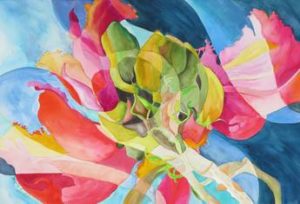Dear Artist,
A subscriber wrote, “I need help with ‘developing ideas.’ I have to show I can do this in my portfolio to apply for art school and although it is an admission of a lack of imagination to ask, I really need a structure to help me. I have to do more than supply completed works. I know that artists get ideas while working, but how do I develop themes and explore subjects?”
When I first read this it made me think that if you aren’t overwhelmed with ideas already, you shouldn’t be thinking about art as a career. But then I realized that the pros use all kinds of tricks to keep the good stuff coming. Also, art schools ask these sorts of questions in order to determine a student’s potential. Here are a few ideas that might give you a few ideas:
You need to do some “web-thinking.” Using large sheets of paper and starting in the middle, jot down some random ideas and potential projects. Start with your current interests and add fantasies, secret passions and ambitions. Let one idea lead to another and connect them with lines like a spider’s web so they begin to “breed.” Let your thoughts range from simple exploratory sets of works to complex mind-bending installations. You need clear time to take this task seriously so that the process becomes natural to you. Evolved artists habitually and actively bounce ideas between hemispheres. Natural to some, the art of yin-yanging can also be learned. Don’t share with anyone. Live for a while in the embrace of your imagination, no matter how outrageous. Mind-test and envision but don’t give in to early rejection. Associate freely. Anything goes.
Think about your web-thinking at night, while you dream, while putting out the cat. If you are drawing a blank, check out the cat, or the wall behind the cat. Also, think how your ideas might move people, mountains, nations. When you have several sheets filled start evaluating and modifying with a pen of a different colour. Pick out a selection of ten or more and rewrite as if you were proposing film-treatments. Make them short and punchy. If they run from the practical to the impossible, so much the better. As part of your application, present this material using the heading: “Ideas I am currently developing.”
Best regards,
Robert
PS: “Stop sometimes and look into the stains of walls, or ashes of a fire, or clouds, or mud or like places — you may find marvelous ideas.” (Leonardo da Vinci)
Esoterica: Give value to your best ideas forged alone. Charles Brewer, the founder of MindSpring, said, “The good ideas are all hammered out in agony by individuals, not spewed out by groups.” What an artist does with her own web may be the most valuable exercise of her creative life. Web-thinking teaches personal creativity and individualist vision. “I suppose it is because nearly all children go to school nowadays and have things arranged for them that they seem so forlornly unable to produce their own ideas.” (Agatha Christie) Art teachers know this.
This letter was originally published as “Developing ideas” on August 6, 2004.
The Letters: Vol. 1 and 2, narrated by Dave Genn, are available for download on Amazon, here. Proceeds of sales contribute to the production of The Painter’s Keys.
“The idea or the faculty of imagination serves as both rudder and bridle to the senses, inasmuch as the thing imagined moves the sense.” (Leonardo da Vinci)
Featured Workshop
Ghost Ranch, NM, Darla Bostick, (June and October) workshops Relax, enjoy, create! Floor to ceiling studio windows. Ghost Ranch Lodging/meals provided. See why Georgia O’Keeffe loved Ghost Ranch. Each workshop/retreat is different. The June workshop jumps into something new every day—textiles and dye, printing, paperworking and more! The October workshop is for painters—collecting photography for reference, watercolor, ink, acrylic and more–using watercolor paper, clayboard, etc! Daily demos, slide presentations, door prizes and optional happy hour. The website has all the information. Darla’s been teaching at Ghost Ranch since 2008… isn’t it time for you to see why?
Featured Artist
Shawn’s paintings evoke the feelings of the West Coast, its shores and islands, ponds and lakes.









18 Comments
Look up “Mind Maps” for a good visual of the ideas expressed above. It’s a great concept and very useful to watch your own brain in action.
Oh Dear. I feel this subscriber’s pain. I’ve surely been fraught through the years with this type of pressure and it feels very real while it’s happening. It can be positively paralyzing. There are as many reasons for this experience as there are people experiencing it. I have to imagine there are as many solutions.
I can only speak for myself. Perhaps it will resonate for someone else. My mediums are art, writing, songwriting. Sometimes I move to a different medium to stir the creativity pot. As Robert suggested, I’ve used the web method with success! But sometimes, the pressure – as is intimated in this subscriber’s words and tone of voice – is too great for that kind of exercise, feeling even more pressure to perform. It’s like saying “This is my friend. She’s a comedian. Go ahead, Kittie. Show them. Be FUNNY!”
An activity that has worked for me is to starve myself of creating. Plan a week without it. Stay away from the usual stimuli, whatever that might be for you. No television, no “making”, no lists of To Dos with respect to one’s artistic work. Taking a trip somewhere can be very helpful but I find the most effective – and the most difficult – is to stay at home and as much as possible, change up one’s routine. This is so personal but if a person truly sticks to the basic tenet of No Creating, it is amazing how ideas and thoughts come forward and are triggered from the most unusual sources!
Sometimes it only takes a few hours for something to come through. Sometimes it takes days, weeks, depending on the pressure imposed on oneself. Taking away that pressure of performance and then simply doing unrelated activities – organizing drawers, looong walks in the big city or in nature, gardening, planned exercise routine for a week, taking a short road trip, reading a couple of those books stacked by your bedside (and nothing else but reading) – can bring startling results!
The worst piece of advice I was ever given at art school was ‘Be original’, closely followed by ‘Be creative.’ No suggestion was offered as to how these highly desirable goals were to be achieved. It cost me many sleepless nights and a lot of wasted endeavour.
Follow Robert’s advice. That’s my advice.
We all have ebbs and flows. Make a space of time to do nor expect nothing. Read, hike, bake, enjoy your silence; appreciate your breath. Honor your gifts and be thankful for abundant life.
With calmness begin small with scaps. Don’t finish…..don’t have a goal; just do; then move on.
Step back, look, see what’s revealed
For me, the best of the suggestions was, ‘ to keep your ideas to yourself’, for awhile. Somehow sharing them, while still malleable, tends to freeze them at that point of departure from your mind. Beyond that, not being fully formed, unwanted or simply negative criticism can distroy an embryonic before it can stand scrutiny.
Sooooo True for me too. I think in my head “I’ll just share this great idea I have with my friend!” The problem is they ALWAYS have a better one… crushing mine and my will to continue with it.
Very long ago, an instructor left this note in my sketchbook; “See from what you create.”
The fact that I can still remember it after all of these years , when I haven’t the slightest notion where I hid the spare house key speaks volumes.
Sorry, I have the opposite problem, not enough years. BUT:
1. Keep a note pad by the bed and watch those dreams
2. Look at shadows, often very different
3. Tape up a large sheet of news print, take a felt marker and just scribble, wide, loose, sweeping gestures. Then use the trick photographers, use, two L shaped pieces to frame sections of your scribble. Come back in, second color, repeat, look at over laps.
4. Rip up colored paper and make collages.
5. KILL SHOULD, AXE IT, KNIFE IT BUT KILL IT
I’ve taught art, college level and workshops, for 30 years while working as an art director, designer, illustrator and fine artist. I realized two things: 1) very few understand creative process and 2) it’s not taught anywhere except a few career based art schools.
It is both very complex and very simple. There a quite a few moving parts that when viewed separately are easy to understand. Most of the barriers to creativity and authenticity don’t actually exist except in the recesses of the creatives mind. Many aspects of creative problem solving; mind maps, divergent/convergent thought, free association, listing, play, Intent, parameters etc are very easy to learn and life changing when applied.
The number one thing that should be taught in every school at every level and grade is creative and critical thinking. It became something of a calling for me to get the info out to the world, artists and nonartists alike. So I took 2.5 years out of my life and wrote a book about it. I didn’t invent a lot of the content but I made it accessible and understandable. Not aiming for a shameless plug but if interested you can read about on my website. It’s never been more important than now.
What is your website?
Colleen, just click on his name.
Beautiful website and paintings, Larry. Glad to see you will be at the plein air convention; I’ll make a point of looking you up!
I agree, Larry. Critical Thinking is one the BASICS that should be taught from Kindergarten on. It can be as simple as comparing two images or ideas through to synthesizing information. As a former elementary school teacher of the gifted and the regular classroom, I used Selma Wassermann’s Teaching For Thinking Model with great results.
“Don’t share with anyone”?? I do not understand this. Artists, teachers learn from sharing ideas. This is very ungennish. Steal like an artist, filter through your own knowledge and experience to morph a new idea.
He might be saying not to share them until they are refined. Putting an idea out too soon opens it up to critique, negative response, misguided advice. Let it brew. Before the advent of the internet ideas were stored away from prying eyes until fully formed.
Clearly he is about sharing in general but this is a different part of individual process and personal growth.
Only when you already have a strong commitment to that idea. If it’s just a recent flashbulb in your head and you are still toying with it, it is easily destroyed by someone whose opinion you trust.
As a former elementary school teacher, I taught mind-mapping (Tony Buzan) for decades. It was very useful for generating ideas, but additionally for organizing thought, categorizing, preparing for exams. The best ideas come at the end of an episode where ideas can be combined. Another technique, SCAMPER is used by organizational design teams to construct new ideas: Substitute, Combine, Adapt, Magnify/Minify, Put to Other Uses, Eliminate, Rearrange and this I also taught for decades. Please don’t slam all the teachers without knowledge of what is going on, at least in some classrooms.
I love the SCAMPER method for looking at your bud of an idea and developing it in different ways. I’ve used some of these in my own work. But systematizing it in such a straightforward way is a quite handy tool!